#Gilled lungfish
Explore tagged Tumblr posts
Text






#Australian lungfish#Neoceratodus forsteri#South American lungfish#Lepidosiren paradoxa#Marbled lungfish#Protopterus aethiopicus#Gilled lungfish#Protopterus amphibius#West African lungfish#Protopterus annectens#Spotted lungfish#Protopterus dolloi#lungfish#fishes#marine biology#fish#fishblr#aquatic life#aquatic#poll#my polls#random polls#poll time#tumblr polls#polls#polls on tumblr#tumblr poll#polls polls polls#polls are fun
171 notes
·
View notes
Note
can we get some dipnoi love i love these little guys
Of course, our fishy lobe-fin cousins deserve some love <3
Daily fish fact #591
Gilled lungfish!

They're notable for having three pairs of external gills which they retain into adulthood, and also for being the smallest lungfish species! Despite the gills, they're still obligate air breathers and can handle being buried in dried mud for months just like the other lungfishes.
#i find it very interesting how much they look like aquatic salamanders!#we're all just fish... all of us tetrapods....#fish#fish facts#fishfact#fishblr#biology#zoology#lungfish#gilled lungfish#asks#anonymous#anon#anonymous asks
266 notes
·
View notes
Text

Uh oh! Looks like Deare had drunk the wrong potion
Though honestly I think it'd be really cool if in the third chapter we got to be mermaids for a bit instead
Deare is a lungfish, and the oc of a friend here is a sea horse (for some reason I didn't want to draw Deare alone)
Fun facts about mermaid Deare, Deare very much can drown so they should be glad it was a water breathing potion instead
Floyd still would call them shrimpy as they still aren't as long as him and it's a more fitting name then lungy
@twisted-tech Hope you enjoy them!
#it's also less cruel to call Deare by a nickname based on their fish species#since I chose the lungfish to highlight how they don't fit in twisted wonderland#and how they are hurt by their stay in twisted wonderland#lungfish breath air and are capable of drowning#though they have gills and like the lungfish Deare does eventually adapt and get their shit together#also my friend wants to keep private that's why there is no credit there#yuusona#mermay#twistedtech_mermay23#twistedtech mermay23#twst oc#twisted oc#twst yuu#twisted wonderland oc#twisted wonderland yuu#purbart#disney twst#twisted wonderland
10 notes
·
View notes
Note
Hi again! I have another question if you don't mind.
The mer boys have gills on their waist but they also can stay on the surface long enough to have a nap. It's logical to assume they have lungs or an analogue of them like lungfish do. How would it be useful in nature? Does growth of lungs stop at some age? I don't think that somone Eclipse-sized could make much use of breathing outside of a water body, I doubt he has a habit of dragging himself out on the big land.

Mers have a pseudo lung, it is not as effective as a real lung but still able to absorb some oxygen. In these pseudo lungs store gasses and funktions simmilar to a swimmblader. Females have bigger lungs than males and are able to make a lot more vocalizations.
Yes, the lungs stop growing at some point and their only use at that point is for vocalization. But before that point, lungs have the function of allowing Mers (specifically Mers that live in freshwater) to travel across land in search fro new waters. Usually, they don't really need to use their lungs to breathe as their gills work as long as they are wet. Plus just like lungfish, their gill can hold water.
If you'd like to keep Sun and Moon outside the water for longer you can throw a wet towel over them, it'll allow them to stay outside for way longer.

164 notes
·
View notes
Text
Round 2 - Chordata - Dipnoi
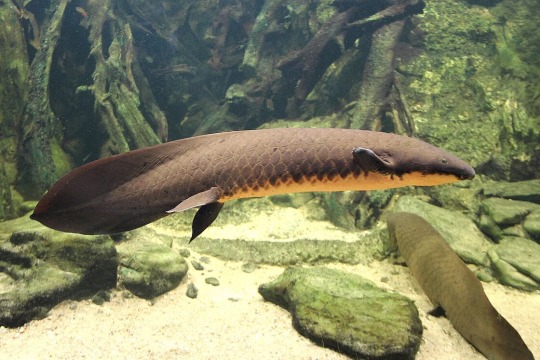
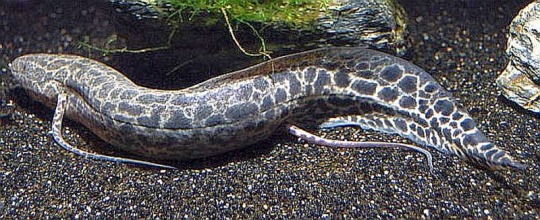
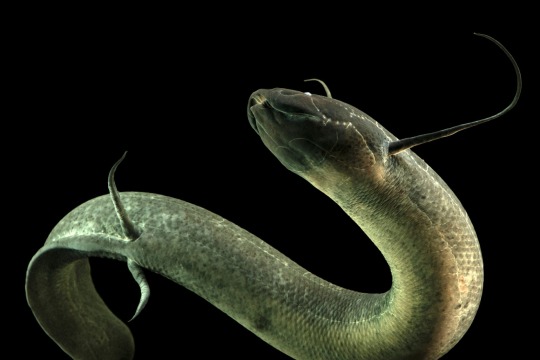

(Sources - 1, 2, 3, 4)
Dipnoi is a class of Sarcopterygiian fish commonly called “lungfish”. While widely distributed since the Early Devonian, today only 6 species remain. They are the closest living relatives to tetrapods (amphibians, reptiles, and mammals).
Like other Sarcopterygiians, lungfish have lobed, bony fins and a well-developed internal skeleton. True to their name, they have a highly specialized respiratory system which includes lungs, subdivided into numerous smaller air sacs. Most extant lungfish species have two lungs, with the exception of the Australian Lungfish (Neoceratodus forsteri), which has only one. The Australian Lungfish can breathe through its gills without needing air from its lung, but in all other species the gills are too atrophied to allow for adequate gas exchange. Lungfish have unique dentition, bearing fan-shaped tooth plates called odontodes, which are used to crush hard shelled organisms. Some groups have ridges on these tooth plates that form occluding blades. They are omnivorous, feeding on fish, insects, crustaceans, worms, mollusks, amphibians, and plant matter. African and South American Lungfish are capable of surviving seasonal drying-out of their habitats by burrowing into mud and estivating throughout the dry season.

(own work)
Propaganda under the cut:
The Australian Lungfish has existed in Australia for at least 100 million years, making it a true living fossil and one of the oldest living vertebrate genera on the planet. It is the most primitive surviving member of the ancient Dipnoi lineages.
The Marbled Lungfish's (Protopterus aethiopicus) genome contains 133 billion base pairs, making it the largest known genome of any vertebrate. The only organisms known to have more base pairs are the amoeboid Polychaos dubium and the flowering plant Paris japonica at 670 billion (possibly) and 150 billion, respectively.
The Spotted Lungfish (Protopterus dolloi) can aestivate on land by surrounding itself in a layer of dried mucus.
An Australian Lungfish named “Granddad” at the Shedd Aquarium in Chicago lived to be 109 years old, before he had to be euthanized due to an age-related decline in health. The current oldest Australian Lungfish is now “Methuselah”, who lives at the California Academy of Sciences, and is around 100 years old. Methuselah has been described as "mellow" by her keeper. She is also noted to like belly rubs, back rubs, and fresh figs.
Australian Lungfish are one of the cutest animals on the planet and I want a life-sized plushie/body pillow of one
86 notes
·
View notes
Text
Fish of the Day
Happy Thursday, everyone! Today's fish of the day is the Australian lungfish!

The Australian lungfish, or barramunda, known by scientific name Neoceratodus forsteri is one of the 6 surviving lungfishes of the modern world. The other 5 lungfishes are scattered to other sections of the world, one in South America, and the other 4 all living in Africa. As the name implies, this lungfish is endemic to Australia living in South Eastern Queensland, or for those who don't know the general areas of Australia, the upper right corner of the country. Living exclusively in slow moving streams, still waters, and various waterside banks living entirely in freshwater systems. This fish is primarily nocturnal, and almost entirely carnivorous. Its diet consists of: frogs, larvae, bugs, plant material, earthworms, fishes, small invertebrates, and anything else it can catch. They are primarily bottom dwellers, and prey is caught directly in the mouth and then crushed multiple times, being positioned correctly by a bone called a hydroid apparatus. Australian lungfish have the most primitive of surviving lungfish feeding behaviors.

Australian lungfish are best known for their ability to survive dry seasons. However, unlike African lungfish, which can survive fully in droughts by submerging themselves into This is done by submerging the body in the mud, and rising to the surface to swallow oxygen into a single dorsal lung. This lung is only supplementary, and the fish prefer to breathe through their 5 gills. Of the six lungfish, the Australian lungfish is the only one to not have two lungs, but rather a fold down the center of the single lung acting as a wall, which blood capillaries run through, allowing gas exchange. Unlike it's African counterparts, the Australian lungfish can not survive total water depletion, (other lungfish survive this by creating a layer of mucus around itself and living there for several years until water returns). Australian lungfish can survive several days out of the water, but can not do so unless it is in a moist environment, usually mud.
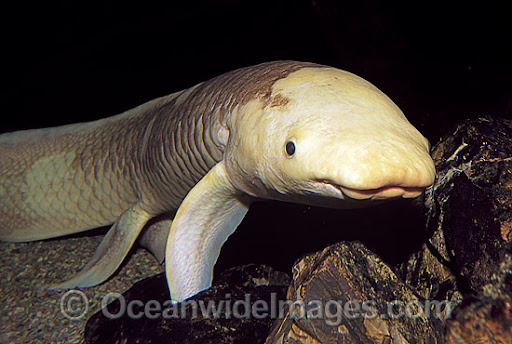
Fossil records of lungfish tell us that some of their first fossils can be found from 410 Million years ago, being the closest living relative to the tetrapod. The last shared ancestor between the lungfish and tetrapod was 420 Million year ago. Originally, these animals started as marine creatures, but sometime in the carboniferous the species became freshwater exclusive, around the same time that the last common ancestor to all remaining lungfish lived. Australian lungfish in particular appear to have split off about 380 million years ago, and have remained virtually unchanged from their ancestors for over 100 million years, giving them the title of living fossils!

Not only have they remained incredibly similar over the years, they have a long lifespan for individuals as well. A captive Australian lungfish named granddad was shown to live to 108 years (+- 6), with the expected lifespan of wild lungfish surviving at least 20-25 years after they reach sexual maturity. In Australian lungfish, similar to other lungfish species in the world, sexual maturity is reached in males after 17 years, and 22 years in females. Australian lungfish have elaborate courting rituals consisting of three distinct phases. The first phase is searching, where the lungfish will breathe loudly, making mating calls with its single lung. The second is called "follow the leader" where males will attempt to entice a female by nudging and rubbing snouts with her, often at the same time as competitors. The last stage is where two lungfish will descend to lay and fertilize eggs, females producing 2 eggs per spawning season. After breeding, the eggs are left to sink in the vegetation, as Australian lungfish do not nest or care for their young. This is unlike all other lungfish species.
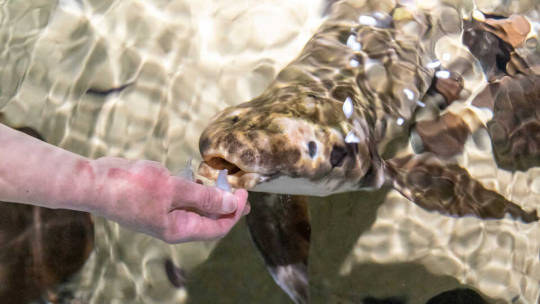
Have a wonderful Thursday, everyone!
#fish#fish of the day#fishblr#freshwater fish#freshwater#australian lungfish#Barramunda#queensland lungfish#lungfish#australia#living fossils
117 notes
·
View notes
Note
Lungfish :) Used to not think about them very much, thought, “I should think about them more,” went to the aquarium, saw one, got hit with lungfish love and appreciation like a TRUCK. They’re amazing fish, very seldom talked about here compared to coelacanths! They’re even more closely related to tetrapods than coelacanths are, most have these silly long fin limbs which would look cute in teeny tiny long striped socks, they’re extremely hardy animals! Some species can survive for months or even YEARS in the mud at the bottom of a dried up body of water, breathing with the use of their lungs! Their lungs have air vesicles just like tetrapod lungs, and as a matter of fact all lungfish species besides the Australian lungfish must breathe air periodically as their gills are not enough. They can even regrow their limbs?! They’re mighty cute too, they’re even more snakelike than snakehead fishes in my opinion. They ought to be appreciated :D
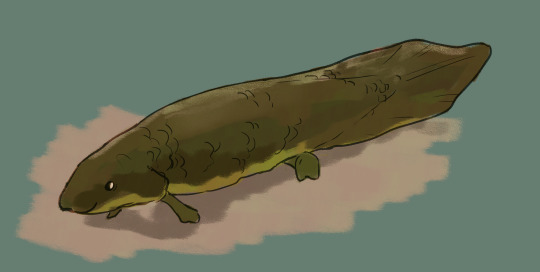
oh i am absolutely a lungfish convert. i love their little feet! this one's an australian lungfish, and i chose it because the reference pic i used had such a charming little smile. thank you for introducing me to this lad
98 notes
·
View notes
Text
Mod 2 General Topics
Types of Fins
Fins are thin, broad folds of integument internally supported by fin rays, they aid in locomotion in various ways depending on the type of fins.
There are 2 kinds of adult fish fins: unpaired median and paired lateral.
Unpaired median fins include 1-2 dorsal fins along the mid-dorsal line, a ventral anal fin behind the anus/cloaca and a caudal fin around the tip of the tail.
Paired lateral fins include pectoral fins anteriorly and pelvic fins posteriorly. Pelvic fins are called thoracic when located below the pectoral fins and abdominal when located just above the anus. Absent in some.
Under unpaired fins there are many types of caudal fins. Caudal fins are well developed in most fish because of its important contribution to forward propulsion during swimming. The 3 main types are: diphycercal, heterocercal, and homocercal.
Diphycercal Fins:
The most primitive, not exhibited by many living fish.
Vertebral column extends straight back to the tip of the tail, dividing the fin symmetrically and equally into the dorsal and ventral lobes.
Occurs in cyclostomes, primitive sharks, and lungfish.
Presence of diphycercal tail in developed fish is due to secondary modifications.
Heterocercal Fins:
Intermediate type.
The caudal fin is strongly asymmetrical.
Vertebral column bends upwards and reaches up to the tip of the more prominent dorsal lobe.
Characteristic in bottom feeders with a ventral mouth, the stroked of the large dorsal lobe directs the fish downwards.
Occurs in modern sharks.
The opposite, a large ventral lobe, is found in flying fish to propel them upwards. This type of fin is called hypocercal.
Homocercal Fins:
The most advanced type and the most common.
Characteristic of most higher bony fishes.
Externally symmetrical but internally asymmetrical.
The original dorsal lobe or epichordal is suppressed, the original ventral love is developed into a single or 2 symmetrical lobes.
Characteristic of fishes with a terminal mouth, its strokes force the fish straight forward.
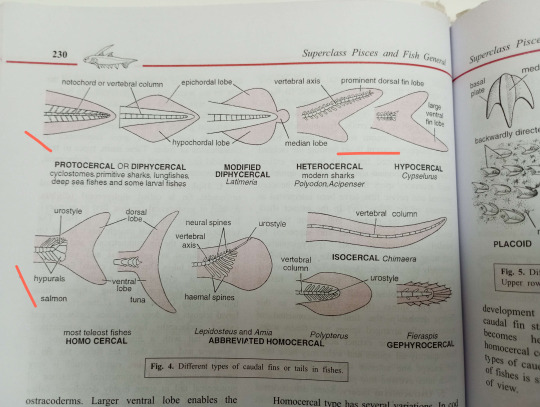
Types of Scales
There are 5 types of dermal scales: Cosmoid, Placoid, Ganoid, Cycloid, and Ctenoid.
1. Cosmoid Scales:
Does not occur in living fish, only fossilized fishes.
2. Placoid Scales:
Characteristic of sharks.
Each scale has a backwardly directed spine arising from a round or rhomboidal basal plate embedded in dermis.
Spine is enamel-like and basal plate is of dentine-like bony material.
A pulp cavity inside the spine opens through basal plate.
Placoid scales are closely set together in skin; giving a sandpaper like texture.
3. Ganoid Scales:
Thick, rhomboidal, or diamond shaped plates closely fitted side by side. Tile like, provide a bony armor to the fish, might overlap in some.
Characteristic of holosteans.
4. Cycloid Scales:
Thin, flexible. translucent plates. Circular in outline and thicker in the center.
Marked with several concentric lines of growth which can be used to determine age.
They overlap each other, each scale is embedded in a small pocket of dermis.
Found in lung fishes, carp, cod, etc.
5. Ctenoid Scales:
Similar to cycloid scales in form, structure, and arrangement.
But is more firmly attached, their free hind parts with are not overlapped, bear numerous small comb-like teeth or spines.
Characteristic of modern higher teleosteans like perch and sunfish.
There are some intermediate types of scales found in between cycloid and ctenoid, and some fish like flounder have both.
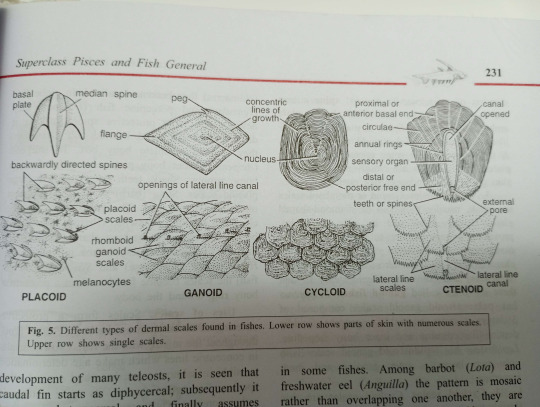
Neoteny and Paedogenesis
Neoteny refers to the retention of a larval or embryonic trait in the adult body. For example the retention of larval gills in adult salamanders.
Paedogenesis refers to the development of gonads and or production of young by an immature larval animal. Examples are scattered in several groups or animals such as gall fly, liver fluke, and salamanders.
Neoteny emphasizes the retention of larval traits in the adult body while paedogenesis stresses the development of adult like gonads in the larval body.
The best example of neoteny and paedogenesis is ambystomata. Normally they live through an aquatic larval stage and transform into an air-breathing terrestrial adult. However, under certain circumstances, the larvae does not undergo metamorphosis, retains it's gills and aquatic nature, but becomes sexually mature. This sexually mature larval stage with external gills is called an axolotl.
For a while axolotls were thought to be an entirely separate genus, Siredon.
Environmental factors affect metamorphosis in many ways. Abundance of food, cold temp., and insufficient iodine may cause failure of metamorphosis and paedogenesis. This is known because drying of swamps, lack of food, and rise in temp induce axolotls to metamorphose. When treated with thyroxine or TSH, they lose their gills and become adults.
There are 3 types of neoteny, partial, intermediate and total.
Partial neoteny is then metamorphosis is delayed due to temporary ecological or physiological changes, seen in tadpoles over winter.
Intermediate neoteny is when the organism is sexually reproductive and can undergo metamorphosis under the correct conditions, seen in axolotl.
Total neoteny is when they remain larval throughout. Even after treatment of thyroxine, they fail to metamorphose. Seen in Siren.
Parental Care in Amphibians
Parental care is the act of looking after the eggs or young until they are independent enough to defend from predators.
Amphibians exhibit various types of parental care in two broad groups: Protection by nests, nurseries, or shelters and direct caring by parents.
Protection by nests, nurseries, or shelters:
1. Selection of site: Many amphibians lay their eggs in protected moist microhabitats. Some frogs and toads lay eggs on land near water. Many tree frogs lay their eggs on leave and branched overhanding water by gluing their eggs, they fall into water free of predators when hatched. Some tree frogs deposit eggs in water that accumulates in epiphytic tropical plants, free from aquatic predators.
2. Defending eggs or territories: Male green Rana frogs maintain territories and attack small intruders to protect the eggs. Both male and female Mantophryne frogs guard the eggs. The male actually sits over and holds the gelatinous envelope containing 17 eggs.
3. Direct Development: In some frogs such as Hyla, the eggs hatch directly into little frogs, thus avoiding the chance of larval mortality. In the red backed salamander, the hatchlings are miniature adults.
4. Foam Nests: Many amphibians convert copious mucous secretion into nests for young. Japanese tree frogs dig a hole or tunnel into which eggs are left in a frothy mass to avoid desiccation. During rain, the hatching tadpoles are washed down the slopping tunnel into pond or river water for further development. Some frogs lay eggs in nests of foam floating on water. The female emits a huge amount of mucus that she can beats into foam with her hindlegs to lay eggs in. When tadpoles hatch they drop from foam into water.
5. Mud nests: Brazilian tree frog, Hyla, the male frog digs little holes in the mud of shallow water for the female frog to lay eggs in. The nest is 30cm in diameter and 5-8cm deep. Tadpoles hatch within this safe place and develop until they are large enough to defend themselves.
6. Tree nests: The South American Tree frog, Phyllomedusa, lays eggs in a folded leaf nest with margins glued together with cloacal secretions. The tadpoles when formed fall straight into water below.
7. Gelatinous bags: Salamandrella, a small aquatic salamander, deposits 50-60 small eggs in a gelatinous bag which is fastened to aquatic plants.
Direct Carrying By Parent
1. Coiling around eggs: In certain caecilians like Ichthyophis, the female lays large eggs in burrows in damp soil and carefully guards them by coiling her body around them until they hatch.
2. Transferring tadpoles to water: Some species of small frogs in tropical Africa and South America deposit their eggs on ground. Once the tadpoles hatch, they fasten themselves to the back of one of the parents with their sucker like mouth so they can be transported to water.
3. Eggs glued to body: Many amphibians carry the eggs glued to their body. In the Sri Lankan tree frog, the eggs are glued to the belly of the female. In the European midwife toad, Alytes, the mall entangles the eggs around his hindlegs so he can carry them with him until they are ready to hatch. When the time comes they release the tadpoles into the nearest water body.
4. Eggs in back pouches: In a group of tree frogs called marsupial frogs, the female carries the eggs on her back. Either in an open oval depression, a closed pouch, or individual pockets. The eggs develop into miniature frogs before leaving their mother's back.
5. Organs as brooding pouches: Males of the terrestrial South American Darwin's frog, Rhinoderma, pushes at least 2 fertilized eggs into his large vocal sacs. There they undergo complete development to emerge out as fully formed froglets.
6. Viviparity: Some anurans are ovoviviparous. They reatain eggs in the oviducts and the female gives birth to living young. For example African toads give birth to little frogs.
#zoology#vertebrates#fish#frog#neoteny#parental care#fins#scales#notes#biology#exam season#please help#amphibians#axolotl
62 notes
·
View notes
Note
H:actually yes the native from envy can breathe air to
H:they have both gills and lungs, kinda like Lungfish
Please, rant to me about whatever is on your mind.
Whatever is on my mind? Ok
The deferent type of demon in my world and how to identify them explained by Hillian, here you go Hillian *give Hillian a mic*
H:thank you Mx creator
H:ok so there 3 comment types of demon there's the imp the succubus and the demon
H:the imp is the weakest type of demon they aren't as physically strong as a demon or as magical as a succubus, how to identify an imp
H:imp's are relatively short with the tallest an imp ever gets being 5,0ft, they have red skin and white or black hair/horn, and their eyes are a bright yellow
H:succubus are stronger than the imp's and weaker than the demons but they are more magical, how to identify a succubus
H:the succubus is usually about average height, with their hair, skin, horn, eyes and wings colour being the same colour, they have ater bat like wings or bird like wigs
H: demon are the strongest type of demon, being stronger than both the imp and succubus, but being weaker in magic than the succubus
H: how to identify a demon, demon are usually taller than the average height of humans, they have normal human skin colour and their hair and eye colour are dependent on their rank,
H:the ranking system of hell works like this, even before birth you are already given a rank and your eye and hair colour shows what rank you are, the rarer the eye and hair colour the higher the rank
H:while the horn tail and wing colours are dependent on which rings of hell you are born in
H:•Red is for pride
•Orange is for wrath
•Yellow is for gluttony
•Green is for greed
•Blue is for lust
•Dark pink is for envy
•Purple is for sloth
H: and that Ms Mr and Mx are the type of demon and how to identify them
H:if you have more to ask or have something specific you want to ask please do so I'm always here to answer them for you
40 notes
·
View notes
Note
why do some fish have lungs?
To breathe, of course.
Ha, I know that answer will not satisfy you. The fish you are thinking of are the aptly named “Lungfish”. They have lungs for… well. A lot of reasons, reely. Evolution, adaptation, specific needs in their habitats. Let’s ink about where exactly do lungfish live. The three families of extant lungfish are Protopteridae, Lepidosirenidae, and Neoceratodontidae. They live in Africa, South America, and Australia respectively. These areas can get incredibly hot and dry during the summer reasons, and this could very well be the reason behind this strange adaptation.

Pictured here is the West African lungfish. Known for its elongated, tendril like fins, it’s distinct snout, and yes… it’s lungs. This fish is an obligate air breather, meaning every 30 minutes or so it will surface to take gulps of air. Unlike most fish, this one is better at extracting oxygen from the air with its lungs, rather than oxygen from the water with its gills. Still, this fish requires a good body of water to survive. During the dry season, however, the rivers these fish reside in can dry up. For this reason, a lungfish can burrow in the mud and enter a period of “Estivation.” Similar to hibernation, the fish will remain inactive and will return when water levels rise again.
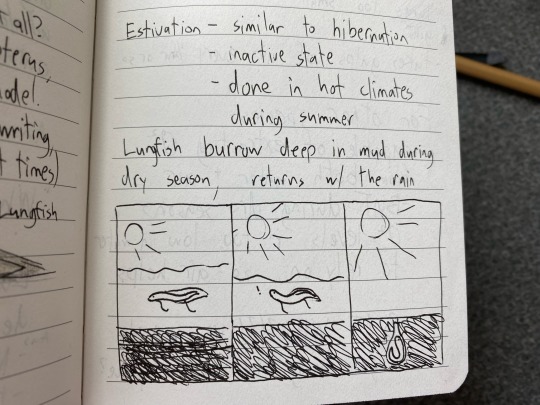
This is a problem that many other lungfish face during the dry seasons. When oxygen levels in the water are too low for gills to reliably work with, then they can turn to the air to breath. Isn’t that nice? Did you know the West African can make a cocoon of mucus for itself when it burrows? And said mucus makes a sort of breathing tube for itself from its burrow to the surface, like my very own breathing tube. I’d imagine it would be quite comfortable to sleep underground for an extended period of time. A nice, dark, enclosed space all for myself.
I hope this answers your question Anon. The short answer: Lungfish have lungs to extract oxygen from the air. The long answer? Whale I’ll have to dive into the whole evolution spiel. I haven’t even gone into primitive lungfish such as Dipterus…
Misty confinced me to post these illustrations as well. Initially they were cut just to keep things shrimple, but she told me that they looked “cute” and “nice”. I said “shore, whatever you say.” Maybe I should practice drawing some more…

#deep diver#toontown#toonblr#toontown corporate clash#ttcc#prob art#corporate clash#lungfish#I love when I get to do homework for this blog. I love learning about fish.
33 notes
·
View notes
Text
Perhaps my most controversial take is that Saint might not be a slugcat.
If we consider Survivor (and to a lesser extent Monk and even Hunter) as the quintessential example of a slugcat, we have the basis for what actually counts as one. From there we have to look at the deviants from basic form and determine how severe they deviate- which I think all others but Saint don't go to far. Spearmaster- Modified organism using a slugcat base. Stretching the definition of a normal slugcat here maybe, but more or less still resembles the rest of the group minus the obvious. Definitely not considered a member of the same species though. Artificer- Minus the weird explosion bacteria, it is a normal slugcat in terms of form Gourmand- Literally just fat and strong. Perfectly normal fella. Rivulet- Okay this is where we get interesting. Rivulet is both the first to deviate notably from the basic slugcat in terms of readable physical traits, and is also set further in the timeline. An evolutionary split from what a 'slugcat' is fully possible. However, their actual traits are rather minute. Rivulets main trait is the presence of external gills, suggesting an aquatic adaption. However in real world examples of external gills they are mostly a development of species that already had gills in some form in either their lifecycle or biology. The most obvious inspiration for rivulet's design is likely the axolotl, which is a salamander that has neotenic (juvenile) traits due to never metamorphosing. If you force metamorphosis, an axolotl looks like a normal salamander
Gills or gill-like structures can also be internal or land-modified- Spiders for example have book lungs, which are likely evolved from book gills (whereas in human evolution our gills did not evolve into lungs, and gills instead 'turned into' parts of our skull and ears) you can also have lungs and gills, as seen with certain species of lungfish. It seems perfectly reasonable to guess that the slugcat- either currently or historically- made use of a gill or gill-like system- which would set rivulet up for either a reemergence of the trait or as an alternative evolutionary path. I could easily see the rivulet 'type' of slugcat existing alongside the normal species, just isolated to coastal and other floodzones- or as one of several independent cases of the external gill trait emerging. Complicating things further- Sea slugs make use of gills in several forms, while (most) land slugs have lost their gills and created a simple lung out a hollow cavity. There is also at least one slug that completely lacks both lungs and gills and breathes entirely through their skin. Lots of variety there within a group. What we can confirm though is that at minimum- slugcats do have a nose. However the presence of the nostrils alone doesn't tell us the fine details; Frogs also have nostrils and make heavy use of them for the vast majority of their breathing, but also have permeable skin that also allows for oxygen exchange (particularly while under water). So its complicated. All this is a very complicated way of say that there's no real indication that rivulet is all that particularly unique compared to the basic slugcat, minus the gills- which are something that could be a perfectly normal trait to develop without getting too far from the traits that make a slugcat a slugcat. It would be, at minimum, its own species though. Genus you could argue about. And then we get to Saint. Saint is ages forward in the timeline for our 'basic' slugcat, to the point where even lizards have heavily shifted their evolutionary patterns and there have been notable extinctions within the window the game provides. Saint itself has a very notable deviation: Very obvious long fur (or at least, something convincingly playing the role of fur). While furry slugcats (whether that be more cat-like or fine fur like a seal) is popular in fanon works, official art has an obvious smoothness to it more indicative of bare skin (Although the quality of this skin, such as if its more mammalian or amphibian, etc- is unknown)

While the type of skin could heavily change how big of a deal this is (it would be a lot easier to develop and lose fur with the structure of mammalian skin than amphibian skin; and if we are being technical mammals are the only thing that can truly develop fur/hair) It does at least mark the development of a trait that seemingly took several generations to acquire, at least on par with the development of a fur or fur-like trait in all surviving species of 'lizards' It does seem to intend to mirror, to a degree, the evolution of mammals. Which begs the question... can you really call Saint a slugcat? When you think about what survivor is, and how removed Saint is from them in both physical features and time period... would the term be appropriate? And to be specific, its technically incorrect to say things evolve "into" other things- they split and grow into distinct things (and sometimes all but one dies off in the process). Evolutionary history is difficult to chart for a number or reasons, and its extremely complicated- but when we say something like "snakes evolved from lizards" what it really means is that at some point there was a group of something we agreed were lizards, and then something within that group began to change into something with its own distinct features and traits until we gave it a new name. In the lizard and snakes example, snakes are technically lizards. Just lizards with very specific traits we don't consider lizard traits. But you also have examples like mantodea (Mantises) and Blattodea (Roaches and Termites).
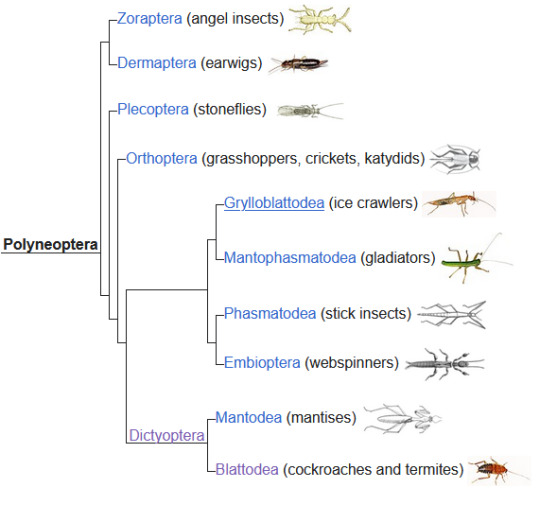
A some point there was something that was neither mantis nor roach (the roachoids, which despite being more roach-like than mantis-like we don't consider them proper roaches), that split into things that would go on to form the basis of those groups (and then termites would split from there, making termites technically a type of roach). And for the rest of history humans would argue constantly about what to do with this mess So really the question is what do we consider a slugcat, and is Saint part of an evolutionary lineage that 'slugcat' applies fully across, or does Saint mark a split into something else, that would technically go alongside "true" slugcats under a wider net. Slugcat definitely isn't a singular species and I lean towards genus but could see an argument for family or order. Lets do DNA analysis on pixels and find out they are actually a type of lantern mouse
#thinking about this gave me a headache#im on team saint isnt a slugcat this a sinister new creature#anyway taxonomy already makes my head hurt and doing it with thats that have 200 % less information#sucks a little bit#but i do just really like the idea of an iterator being like errrm technically this isnt a slugcat the newest info put it in its own clade#rw bioposting
16 notes
·
View notes
Text
Daily fish fact #882
Australian lungfish!

Unlike all other lungfish species, the Australian lungfish has a single lung instead of two separate lungs! It usually relies on its gills for breathing, but when droughts occur and the conditions become tougher to bear it'll swim to the surface to take gulps of air.
73 notes
·
View notes
Text

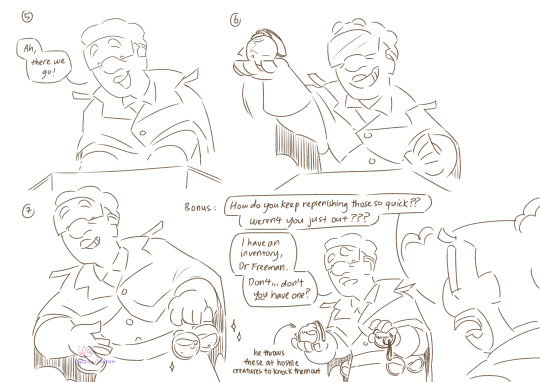


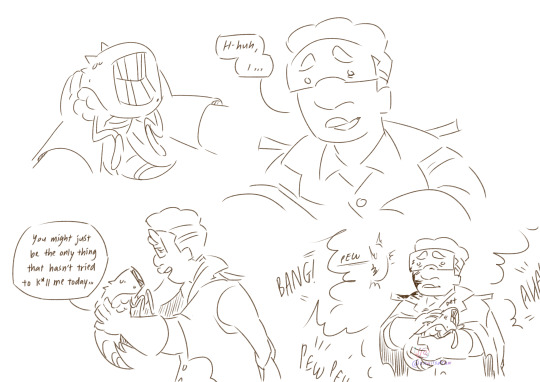
[Start ID: 4 more pages of HLVRAI doodles about Darnold joining the Science Team and Half-Life creatures. Warning for blood in the 4th page.
Before the Science Team leaves the Mixology Department Lab, Darnold has to arm himself. He holds a conical flask and wine bottle with a silly straw stuck through the cork, both containing sleep potion, looking around: "Hmm…I'll need somewhere to store these…something…" He spots a box of decorations on the nearby shelf and his eyes light up: "Oh!" He picks it up with a delighted "Aha!" and sets it down on his lab table. "I know everyone's been telling me to stow these away somewhere, but I always knew we'd need them someday," he says, beginning to rifle through the contents and past a coil of fairy lights until he finds what he's looking for and exclaims, "Ah, there we go!"
He raises a transparent glass bulb ornament with a string attached on top out of the box with a huge grin. Later, he proudly shows off the now sleep-potion-filled glass bulbs hanging from a belt he's since buckled around his waist. He now has a defense weapon he can throw at hostile creatures to knock them out without killing them. Bonus drawing: Gordon is disturbed by how Darnold seems to never run out of his potion-bulbs even though he's been slinging them consistently. "How do you keep replenishing those so quick?? Weren't you just out???" he asks. The four potion-bulbs strapped to Darnold's belt haven't gone down in numbers despite having taken two in his hands. He looks at Gordon, puzzled: "I have an inventory, Dr Freeman. Don't…don't you have one?"
Separate scenario: Benrey shoots a reproachful look at the Snark creature he's holding in his hand, his other hand it bit held away from it: "ow, aw wuh the hell bro, no biting." The one-eyed, bug-like alien hisses at him, ready to go again. Benrey begins shoving the Snark into his mouth, only delayed in progress by the angry, screeching creature holding itself back with its two hooked front legs. Gordon yells at him: "Wh- DON'T FUCKIN' EAT IT?!!"
Separate scenario: Darnold holds up a docile Spore Launcher, the puppy-sized, toothy, lungfish-like creature quiet in his hands. It has a smooth rounded skull crowned by spikes, two spindly front legs, gills along its side and trailing tentacles. Darnold looks at it, the nervousness melting from his face. His mouth turns up in a little smile: "H-huh, I…You might just be the only thing that hasn't tried to kill me today..." Extra drawing: Darnold, with the right side of his head sprayed with blood and wearing a tight-lipped smile, pets the Spore Launcher cradled in his arms to soothe himself as fighting and gunshots ring out around him.
End ID.]
Previous parts to the Darnold saga found here: [Part 1.]
I love Spore Launcher so much *hands it gently to Darnold* your emotional support, sir.
Thanks to my friend for imparting to me the wonderful knowledge of Half Life creatures <3 [heart] (you know who you are >:))
#hlvrai#hlvrai darnold#hlvrai benrey#hlvrai gordon#spore launcher#snark#snail's art#id#tw blood#cw blood
151 notes
·
View notes
Photo


March’s Fossil of the Month - Acanthostega (Acanthostega gunnari)
Family: Acanthostega Family (Acanthostegidae)
Time Period: 365 Million Years Ago (Late Devonian)
In life, Acanthostega gunnari would have likely resembled a cross between a lungfish and a salamander, and this isn’t dramatically different to what it really was; Acanthostega was a stem-tetrapod, an early member of the lineage of animals that now contains all reptiles, birds, mammals and amphibians, and is believed to be an example of a key stage in the transition between fleshy-finned fishes and the earliest terrestrial vertebrates. Although it possessed 4 short limbs ending in wide, 8-toed feet, the lack of any clear wrist or ankle joints suggests that Acanthostega likely couldn’t support its weight on land, and this combined with its well-developed pelvic bones implies that it was likely a fully-aquatic animal that primarily relied on a paddle-like fin on its tail to propel it forwards while its limbs were used to steer or possibly to grasp aquatic vegetation. During the late Devonian much of the world (including the area of what is now Greenland where Acanthostega fossils were first discovered) was covered in humid, swampy deciduous forests, and this combined with Acanthostega’s anatomy suggests that it likely inhabited warm, oxygen-poor forest pools, which would also explain one of its more unusual characteristics; in addition to possessing fish-like internal gills (as suggested by the presence of gill arch like structures at the base of its skull), a rudimentary rib cage implies that Acanthostega likely had lungs, allowing it to extract oxygen from water as well as air and thereby survive in shallow, oxygen-starved pools that fishes and larger stem-tetrapods would have struggled to breathe in. The teeth of Acanthostega (which were arranged in two rows and were short and sharp, with two larger fangs on the lower jaw) implies that it was likely carnivorous (possibly feeding on terrestrial arthropods caught from above-water beds of vegetation or the banks of its home pools), and comparisons of the anatomy and mineral makeup of fossils of smaller individuals (believed to be juveniles) with those of larger individuals (which are generally believed to be adults) implies that it grew slowly, possibly taking up to 6 years to reach full maturity (at which point most individuals were around 60cm/23.6 inches long, although the difference in the length of seemingly mature individuals suggests that, as with many fish, adverse environmental conditions could considerably limit Acanthostega’s growth.) Although it is unlikely that Acanthostega or its descendants ever succeeded in colonizing land, it is generally accepted that (having become so well-suited to life in the oxygen-poor pools they inhabited) they had little need to, and as several of Acanthostega’s fellow stem-tetrapods (such as the significantly larger Ichthyostega, which had jointed, six-toed limbs and a more developed rib-cage that likely allowed it to haul itself onto land for prolonged periods like modern mudskippers or seals) are known to have done so, the study of the anatomy and lifestyle of this strange little swamp-dweller can still help to shed light on how the variety of land-dwelling vertebrates seen today came to be.
--------------------------------------------------------------------------
Image Sources
Fossil: https://commons.wikimedia.org/wiki/File:Acanthostega_gunnari.jpg#/media/File:Acanthostega_gunnari.jpg
Restoration: https://www.10tons.dk/acanthostega-gunnari
#Acanthostega#acanthostega gunnari#animal#animals#prehistoric animals#wildlife#prehistoric wildlife#devonian wildlife#zoology#biology#paleontology#stem-tetrapod#stem-tetrapods#evolution
94 notes
·
View notes
Text

From mammals to fish. Here we have a more basal relative of the common dragon previously posted here. This one is riverine and they are quite rare, think of sarcopterygians in our world, lungfish and such.
As all dragons they have electric organs though not very strong as in later forms. Another basal trait is that they dont have lungs as developed as the ones in other dragons and can pretty much still breathe with just their gills if they wanted. They live in murky waters though and so need to breathe air from time to time or else they would drown. They use electroreception and their whiskers to sense their surroundings. Another basal trait is their unfused head/thorax.
#worldbuilding#art#illustration#spec bio#speculative biology#spec evo#speculative evolution#speculative zoology#specbio#original species#smaugust 2023#smaugust#traditional art#dragon#dragon art#drawing#fish#fantasy worldbuilding#fantasy creatures#fantasy world#fantasy#fantasy art#fantasy creature
27 notes
·
View notes
Text
Fish of the Day
Today's fish of the day is the longnose gar!

The longnose gar, known well within North America by anglers, and for their distinctive snout. Scientific name Lepisosteus osseus, meaning bony or armor-scaled bony fish. Gars, as a particularly old species are often referred to as living fossils, in that many of them are exactly the same as the fossils of them we have been finding from millions of years earlier, and the longnose gars are no different. Gars first start appearing within the fossil record around 240 million years ago, and are the only remaining decedents of the Ginglymodi clade, a particularly successful fish group in the Mesozoic era. The reason for their low amount if speciation is because gars are the slowest rate of molecular evolution among jawed vertebrates.

These gar fossils can be found worldwide, but the longnose gar can first be found in the fossil records around 1.8 million years ago, fossils found in Cuba, Kansas, Central America, and area in-between. In the modern day the longnose gar lives along mainly the Mississippi River and the Eastern United States freshwater rivers, although they can handle relatively high salinity, giving them the ability to live in estuaries that other gars can not. In these environments they spend their times living in the shadow of vegetation, usually near fallen trees that they can hide within, or near rocky outcroppings that they can camouflage near, or sea grasses.

Referred to as a primitive fish sometimes, this is because their lack of change over the years. The longnose gar in particular is known for having their intestines in a shape referred to as a spiral valve. A spiral valve is a section of lower intestine that is shaped in a stack of potato chips on top of one another, with a spiral going between them, similar to the look of fish gills when opened, found only within animals that are particularly old and living fossils (sharks, sturgeons, lungfish, paddlefish, and gars). Shaped this way for excess absorption. other than this they also have some old trait such as the bony scaling referred to as ganoid scales, which can also be found in some variation on sturgeon.

Their diet consists of mainly insects and crustaceans, and occasionally small gamefish that they can catch, although this is a rare occasion and mostly made up of fry. Other than humans, they not predated upon, and are apex predators in their environments. Their lifehistory is rather long compared to the fish they live around, but shorter than most gar, living 15-20 years, although in captivity there have been longnose gars that live as long as 40 years. These animals spawn in the summertime from April-July, having as many as 30,000 eggs at a time which are spawned in areas of smooth stones, where the eggs will stick. These animals usually reach sexual maturity around 6 years but some males will reach maturity at 2 years of age. Once they reach their full size they can get as long as 4-5 feet and can weigh more than 50 pounds.

Have a wonderful day!
#fish#fish of the day#fishblr#fishposting#aquatic biology#marine biology#freshwater#freshwater fish#animal facts#animal#animals#fishes#informative#education#aquatic#aquatic life#nature#river#ocean#longnose gar#gar#garfish\#Lepisosteus osseus
46 notes
·
View notes